deal only indirectly with other bureaucratic agencies of the corporate state
A concept map like this might visualize what he's describing here. 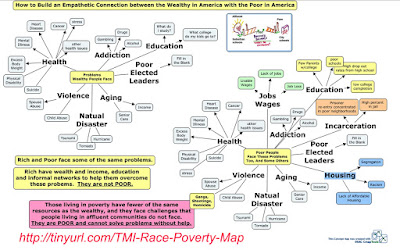
deal only indirectly with other bureaucratic agencies of the corporate state
A concept map like this might visualize what he's describing here. 
possible use of technology to create institutions which serve personal, creative, and autonomous interaction
shows how some people were imagining a future with the Internet as far back as the 1960s, and perhaps earlier.
supports and resources are needed
I started the Tutor/Mentor Connection in Chicago in 1993 to help non-school tutor/mentor programs grow in all high poverty areas. While I shared ideas in printed and email newsletters, and on web sites since then, I've written a blog since 2005. Many of my articles, like this, focus on building the public will and the flow of resources needed to make these programs available in all poverty neighborhoods!
Discussions focused on making supports and resources available should be in every school community, and could be organized an led by students, as well as community volunteers. A map and database could someday show where such planning groups are in place.
support and resources for school infrastructure and platformdevelopment and maintenance are critical
This is the third time in this article that need for a resource or curriculum was mentioned. Would love to find a comment saying "here's on-line space where youth and adults are meeting to solve this problem".
but that this took time to develop
As I posted earlier, this needs to be supported in all schools in a district, starting in elementary school and continuing through high school.
challenge of finding enough time to devote to students reading posts, engaging indialogue, and preparing to go public with their writing
This is an area where schools might find partners who support this learning via non-school programs that meet at locations in the community and during non-school hours.
workingtoward influencing change
this is also a skill that needs to be practiced over and over ...not just as students, but throughout a lifetime.
Youth Voices
Does Youth Voices have any research showing on-going on-line engagement of students who were part of their programs in the early years?
Over time
This is critical. Habits of online learning and engagement, as well as relationships and trust, develop over time, through repeated practice. In a public school setting this would need to be encouraged by many teachers as youth move from grade to grade.
digital civics initiative launched in 2012 called Educating for Democracy inthe Digital Age (EDDA
I wonder if this group has continued to connect annually as the #clmooc group has.
It is crucial for all students to have access
I posted a comment above stating that making these opportunities available should be the focus of an on-going on-line engagement effort, which could be led by students, supported by teachers, parents and/or community volunteers. The #CLMOOC group has used maps, like this, to show participants in its events. Similar maps could be created to show where k-12 youth have adequate access to technology for digital learning and where civic engagement learning is also taking place.
In order to not replicate political inequality, allstudents need opportunities to learn how to discuss civic and political issues
I've not read to the end of this paper yet, but hope there will be some discussion of how to achieve this goal. The cMap that I've attached uses a map at the left to emphasize a planning process that fills geographic areas with needed programs and services. In this case, it would be opportunities for more students in the map area to participate in civic education. 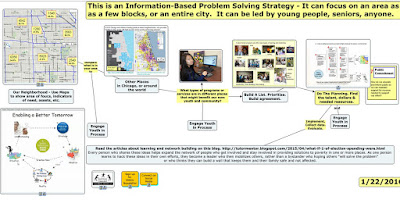
Shared meaning comes from connecting with shared experience,
There are thousands of people who are connected to youth in organized tutor/mentor programs every year, meaning millions have been doing this over the past 50 years.
Connecting with those people has been a goal, and a challenge.
loop
This graphic was created by intern in 2007 to visualize the service-learning loop that takes place in most organized tutor/mentor programs. http://tutormentor.blogspot.com/2017/08/transforming-adults-involved-in.html 
they still get shared tens and even hundreds of thousands of times
I can only dream of my articles being shared this frequently!
lookout for examples of where this is being done well
I've been hosting a directory of Chicago and national tutor/mentor programs since 1993 with the goal that these are examples anyone can learn from. http://tutormentor.blogspot.com/2017/01/what-tutor-or-mentor-programs-are-in.html 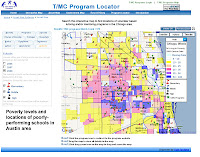
shared meaning is created by connecting with shared experience
Strategy of Tutor/Mentor Connection is to help volunteers connect in organized programs throughout Chicago, to help more people take the same journey I've taken.
I became a volunteer tutor/mentor in 1973, matched with a 4th grade boy named Leo. We've stayed connected over the past 43 years and I've grown my involvement through many leadership roles. My long-term experience has led me into greater depths of involvement.
If more people have a similar experience, and we can connect, then we might do more to help these programs reach k-12 youth in more places.

making complicated subjects interesting
I've been creating visualizations for 20 years to try to communicate complex ideas. One strategy I've deployed is to try to recruit others who might help make my ideas easier to understand. 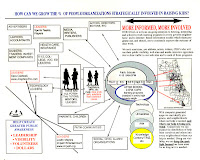
this connecting is done faster through well chosen visuals and metaphors than words
One way I've tried to help others understand my ideas was to enlist interns to take some time reading some of my articles than create their own visual interpretations. This graphic can be found here, along with links to many other visualizations done between 2005 and 2015. 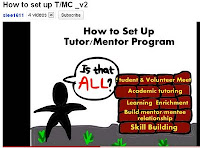
create shared meaning
This cMap is intended to help people converge on a shared meaning, and commitment to a set of actions that lead to the outcomes we want for kids. See article. 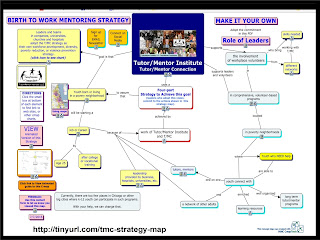
Tim’s point is that zooming out helps you understand better because you see things in context
I've used maps of Chicago since 1993 because they focus attention on all of the places in Chicago where great tutor/mentor programs are needed. I used a map in this Thomas Edison inspired graphic to show that we need to constantly be learning and innovating in order to build and sustain great programs in more places. 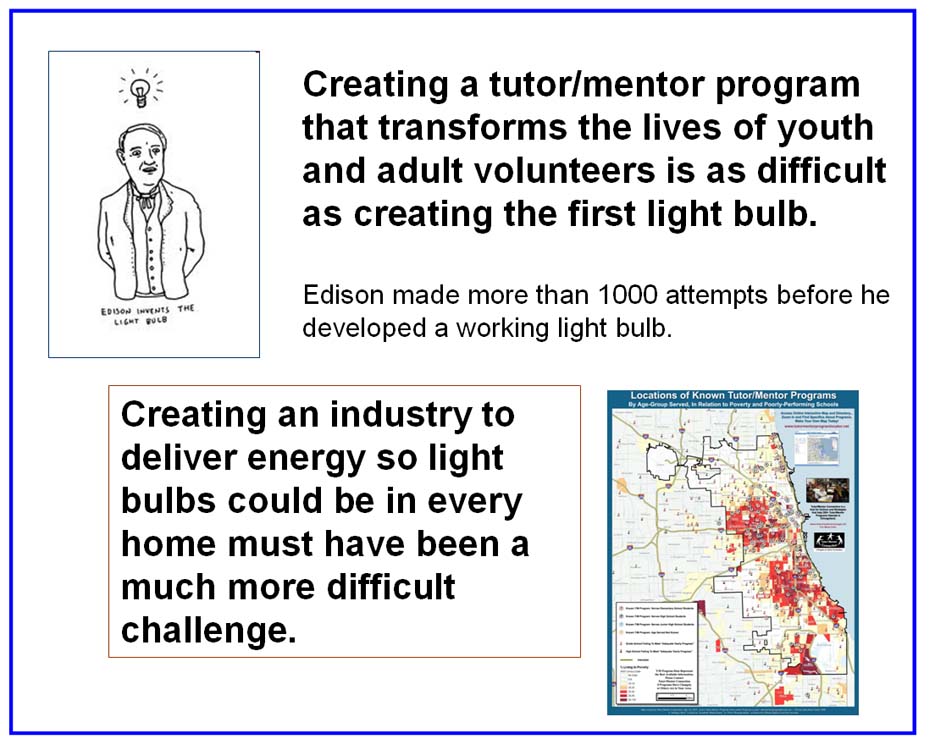
people make fun of me
I've often been told that I'm way ahead of my time, or that I'm so far out in front of everyone else no one can see me.
I don't think those are compliments.
ah right, this is what is going on
I started out 45 years ago asking myself "What am I going to do tonight when I meet with my mentee (Leo)?" Over 45 years that question has expanded greatly to "how do we fill all high poverty neighborhoods with needed programs and services that help kids through school and into adult lives?" I talked about the growing range of questions and created a couple of cMaps to visualize them in this article. 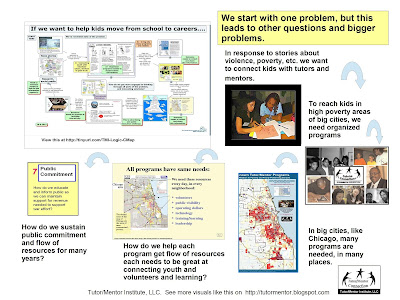
we need to study it, understand how it works, and start doing it ourselves
I used this graphic in articles like this, to show that in order to have great tutor/mentor programs in more places we need to influence resource providers, volunteers, donors and program leaders and staff.
Steve's comment applies.
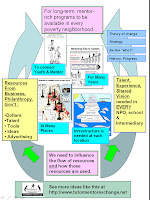
how could I do that road way more efficiently, and how could I do it in a more fun way
I started building a library of research articles and program practices in the 1970s. I learned ideas from them to support what my efforts to do better each day than the day before. I shared them with volunteers in the programs I led, and have shared that library with other programs in Chicago and the world since putting it on-line in 1998. 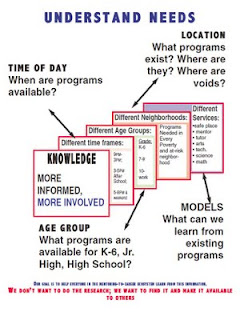
something happened along our life’s journey
For me, there were a series of "somethings". First was being recruited to be a tutor in 1973, then to be the program's leader in 1975. However, there were many experiences over the next 45 years that turned me into the person I am today....and led me to want to share ideas like this.
tis only happens when we latch onto someone who’s incredibly enthusiastic about the subject
I've maintained a list of Chicago non-school tutor and/or mentor programs since 1993 and show on maps like this.
There are nearly 200 programs in my database, and many have multiple sites. Each program needs someone who is "incredibly enthusiastic" about tutoring/mentoring in order to attract and retain students and volunteers.
While I've tried for over 20 years I still find very few people using maps to talk about the need for great programs in all high poverty neighborhoods, and what it takes for programs to be great.
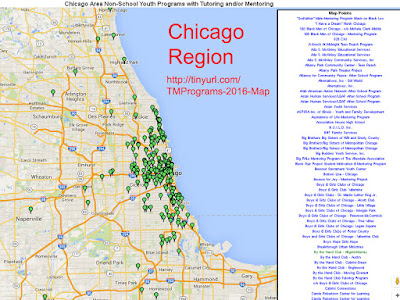
the more you understand something the more you care about it
This has been true for me, and I think for others. In this article I include the concept map I've attached, along with a few other graphics, to illustrate how volunteers who are well-supported in a tutor/mentor program will stay involved longer, and that many will grow greater concern and empathy as a result, and thus, do more to help the youth, and the program. 
I’m super curious
I've always been interested in history. I majored in it in college. Then I was trained in Army Intelligence, during 3 years in the US Army following college. In both cases, I was learning to learn, and learning to use best available information to support decision-making.
When I first became a volunteer tutor in 1973 I knew nothing about tutoring, so began to seek out ideas. When I became the volunteer leader of the program in 1975, I knew nothing about leading an organized tutor/mentor program. I began to seek out other programs in Chicago so I could learn from them.
Over the years I began to understand that our work was more than to provide weekly one-on-one tutoring and mentoring but to build a system of volunteer-based adult support that helped kids move through school and into adult lives. I've used this graphic often to communicate that idea. Here's one example. 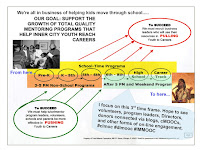
communicate complex ideas in simple ways.
This is one of many graphics I've created to communicate complex ideas. It's in this article. I think I can learn a lot from Tim. 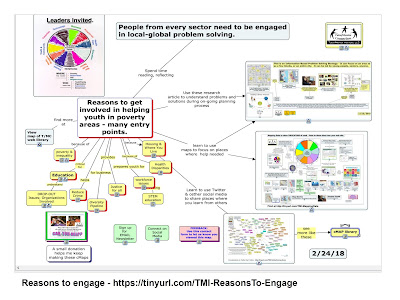
Tim Urban and the art of making complicated subjects interesting
I first connected with Steve Whitla, the author of this article, in May 2017, when I wrote about him in this blog article.
I saw the Tim Urban article in my email this morning and started to read it, then saw it again on Linked in, and took time to read the entire article.
As I did, I saw parts that resonated with me, so asked Steve if I could put it in Hypothes.is for annotation. "Yes" was the response.
Undoubtedly, silence will not protect Black youth from experiencing racial violence, nor will it prevent mainstream media and other social institutions from constructing damaging narratives about them.
I've just finished reading the article. Recognizing and unlearning habits that have been learned over a lifetime is a difficult process. Just growing the number of people thinking critically about this to read thousands or millions is a challenge beyond imagination.
However, one suggestion I offer is to set up an on-going annotation of current media stories, so that negative coverage of Black youth and adults could be highlighted within the context of on-going stories? Since there are different media in every city and state, this could be a class project of students in every city. Over time the repetitive highlighting of negative portrayals might create better understanding among more people.
One positive side affect might be that more students spend time daily closely reading print media and watching broadcast news stories.
Such a study might expand to look at music, TV shows, movies, etc.
Is anyone doing something like this.
Finally, it is important for educators to implement these same tools with White students who benefit from white supremacy and the damaging narratives that mainstream media produce about Black youth and other youth of color.
I was hoping to find this in the article.
As I've read through this entire article I've sense that the burden for understanding and fixing the problem of how Black people are portrayed in media, and how this leads to higher rates of police violence against Black people, is being put on the shoulders of Black youth, which is another injustice.
It needs to be a shared burden.
What do you think
First I want to thank ℳąhą Bąℓi مها بالي for sharing a link to this on Twitter with an invitation to read it.
I'm not part of a university or a professional researcher, but have been building an information library for more than 30 years, intended to be used by myself and others to create and sustain organized, volunteer-based tutor, mentor and learning programs that reach k-12 youth in high poverty neighborhoods and help them move more safely and successfully through school and into careers.
I've been on the Internet since 1998 and beginning around 2000 have been contacted by people from Africa who say they want to "duplicate" the Tutor/Mentor Connection in their countries.
I created a NING community in 2007 and one of my contacts from Africa set up a group which has 27 members, but never much activity.
If you look at posts I've made in the group you can see that I've encouraged them to collect information from Africa, about Africa, because the information in my library focuses on problems in US cities, and Chicago in particular.
My reading of this article reinforces how important that is, but also how difficult it is for them to take this step. I'll share this link in my Ning group, and hopefully a few of them will come take a look.
It seems that one step toward solutions would be to identify Africa based wealth that can be persuaded to support digital learning and Africa-based research and networking of ideas.
Not easy to achieve, but nothing good is easy to achieve.
ultimate end goal of research is publishing papers
I feel that this problem affects the North as well. If publishing is the end goal, who does the work of using the research to solve problems? If money is sucked up by researchers, what's left for doing the actual problem solving work?
consider more deeply the power at the heart of such a one-way knowledge exchange
This represents a huge challenge, in academia, and other sectors. How do we educate and motivate the rich and powerful to consider how their power negatively affects others?
standards and practices that are defined by the ‘center’ of the system
I suspect this observation could be applied to other sectors, such as finance and banking, where the center still controls much, if not all, that happens in the rest of the world...for their own benefit.
Central to our collective future is the recognition that our capacity to survive and thrive ultimately depends on ensuring all of our people what should be an unquestioned entitlement—a rich and inalienable right to learn
The goals in this conclusion are aspirational. However, the conclusion does not point to places where people are discussing strategies that build and sustain the public will (and legislative votes) to actually implement any of these.
Furthermore, the obvious truth—that schools alone are not responsible for student achievement—should propel attention to the provision of adequate health care and nutrition, safe and secure housing, and healthy communities for children. I
yes!
ducational opportunity
Here's an article titled "Education Can't Solve Poverty—So Why Do We Keep Insisting That It Can?"
I keep focusing on non-school volunteer-based tutor and mentor programs as a strategy to build "bridging social capital" in neighborhoods with high poverty....as a recognition that schools and teachers cannot do all that needs to be done.
if students of color were more routinely assigned highly qualified teachers
What's the strategy to make this happen?
the wealthiest districts spend at least two to three times what the poorest districts can spend per pupil, differentials that translate into dramatically differen
While this gap is huge it does not include the difference in community wealth available to support students in affluent areas, vs students in poor areas.
Ironically, had the rate of progress achieved in the 1970s and early 1980s been continued, the achievement gap would have been fully closed by the beginning of the 21st century.
Building and sustaining public will for funding these strategies is greatly needed, but I find few places where strategies to do this are being consistently discussed and funded.
court oversight
Where's the moral leadership? Forcing segregation via court orders does little to address the underlying racism in the US.
marooned in schools where economic struggle is the rule
If you have not read Putnam's book, I encourage you to do so. If you know of articles that frame this problem in social capital terms please post them to Twitter and include @tutormentorteam so I can see them and add them to my web library.
By 2010, about 40% of Black students nationwide—and more than 50% in the Northeast—attended intensely segregated schools (where students of color constitute 90% or more of the total)
A GIS map could have illustrated this, and pointed out where in the nation and Northeast this problem is most severe.
a much weaker safety ne
This cMap illustrates the many challenges children in high poverty areas might face at different times while growing up. Strategies that only focus on schools don't address these other issues. 
students from low-income families is one of the strongest predictors of their achievement.
Dr. Robert D. Putnam's book "Our Kids: American Dream in Crisis" focuses on this. I wrote several blog articles pointing to that book. This graphic was used in several. 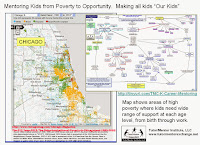
characterizes most of our large urban areas
Since 2008 I've been posting map stories on the http://mappingforjustice.blogspot.com site that illustrate this problem. While I've been using GIS maps since 1993 I still find very few who embed maps in their articles, either to show all the places where this is a problem, or to draw needed resources to these places.
service of power.
Religion has a role in this. Here's a video where the speaker starts out saying "Religion is in the Control Business" https://www.youtube.com/watch?v=wHfSpIIRhFw
Far earlier than the Internet power structures were in place to control people and support the existing power structures.
“Polarization is profitable.”
This is parallel to saying "War is profitable". In both cases...to a few.
The “digital” in polarization
I started using the Internet in the mid 1990s and had an overwhelming hope that because of how the Internet enabled people who care about the same issues to connect, learn, organize and do something about it, we would be giving power to those who historically had no voice and might actually move toward some solutions. I'm still hopeful, but many there are challenges.
key source of the cognitive surplus
Current students, alumni, faculty and administration staff represent a rich resource that could be focused on complex problems that impact lives of all involved. This requires long-term thinking and leadership.
not present at the helm of most classrooms today
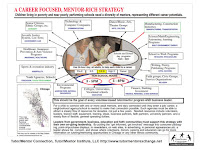
I've focused on non-school tutor/mentor programs because of their potential to attract business volunteers who already use these tools in their daily work. Schools can try to attract these volunteers, too. However, in big cities like Chicago, getting workplace volunteers to schools in high poverty neighborhoods on a regular basis is difficult.
Getting those volunteers into on-line discussions has been equally difficult.
lend a portion of its infrastructure and its time and its endowments to this integrated model of network
Alumni are now making multi million dollar gifts to universities, often with no plan in mind for how the money is being used. I've always felt this was the way to influence universities to adopt the type of strategies that are being envisioned here. Through the Internet these alumni are potentially available to our conversations. In the network analysis that is being done to show participation we need to be learning if any of these types of benefactors are involved. If not, how can we draw them in?
study clubs
 This image visualizes this idea. Anyone can invite others to connect and learn, using the book club model, the Sunday school model, and even the traditional classroom learning model. The role of the person sending the invitation and hosting the gathering cannot be undervalued. See the graphic in this article. http://tutormentor.blogspot.com/2017/12/applying-public-health-strategy-to.html
This image visualizes this idea. Anyone can invite others to connect and learn, using the book club model, the Sunday school model, and even the traditional classroom learning model. The role of the person sending the invitation and hosting the gathering cannot be undervalued. See the graphic in this article. http://tutormentor.blogspot.com/2017/12/applying-public-health-strategy-to.html
regional hubs of expertise, resources, and conversation
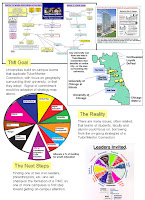 Teams of students, faculty and alumni could build information libraries and host learning and on-going conversations. http://tutormentor.blogspot.com/2017/05/leaders-needed-to-solve-complex-problems.html
Teams of students, faculty and alumni could build information libraries and host learning and on-going conversations. http://tutormentor.blogspot.com/2017/05/leaders-needed-to-solve-complex-problems.html
distributed international network
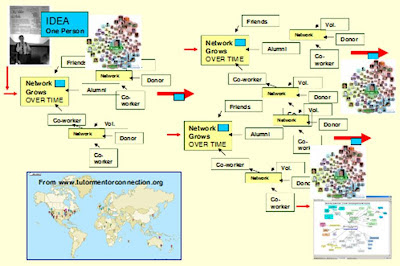 This visualization shows how a small group of people can expand to connect people throughout the world. It's part of a network analysis article at http://tutormentor.blogspot.com/2015/05/report-looks-at-tutormentor-conferences.html
This visualization shows how a small group of people can expand to connect people throughout the world. It's part of a network analysis article at http://tutormentor.blogspot.com/2015/05/report-looks-at-tutormentor-conferences.html
I feel the tutor/mentor conferences I hosted in Chicago from 1994-2015 were an example of Layer One work.
focus on a different sort of poverty and disenfranchisement

This page shows eLearning goals I first posted in 2003 or 2004. Never found partners to fully implement. http://www.tutormentorexchange.net/conferences-and-online-forums/88-e-learning-goals
The one that was going to allow us all to produce and contribute to a shared world of digital artifacts.
This was my vision and has driven my on-line work since the late 1990s.
democracy
I read the Declaration of Independence last night, and looked at it again today. In no place do I see the word "democracy".
What I see is a preamble, then a list of grievances that relate to the self-interests of the merchant class and affluent in the colonies, then a declaration "That these United Colonies are, and of Right ought to be Free and Independent States; that they are Absolved from all Allegiance to the British Crown" and "they have full Power to levy War, conclude Peace, contract Alliances, establish Commerce, and to do all other Acts and Things which Independent States may of right do."
A lot has been read into this, perhaps aided by the drafting of the Constitution several year later.
This statement in the opening paragraphs has opened the door for wide ranging interpretation.
"We hold these truths to be self-evident, that all men are created equal, that they are endowed by their Creator with certain unalienable Rights, that among these are Life, Liberty and the pursuit of Happiness."
equality and freedom—and the power of its language
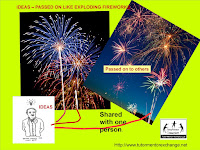
In what ways has that lead to life long actions among day and night students that help create equality and freedom for others in the US and the world? Is a goal of such courses, or civic education in public schools, to propel students into the world as agents for change, or does it only prime the pump, so others might ignite sparks that fuel actions?
I'm now self motivated to read the Declaration of Independence on Hypothesis. See you there.
ideal form, democracies
A year ago I read the History of the Peloponnese War, by Thucydides along with a few others who were scholars themselves (not me). With each chapter someone wrote a commentary that others responded to. Here's one.
There is much from this book that has influence history in the 2400 years since it was written, and continues to influence world affairs in 2018.
well-heeled and all of them well-insured
Unfortunately, most of these students are just making a visit to the University of Chicago neighborhood and because of the education they receive and the networks that helped them get to the University, they will move on and lead lives where they seldom think deeply about the problems facing the night students and others in the neighborhood. What is the university experience doing to change that?
from gunshots and overdoses and chronic disease and battery
In 2008 article titled "They are being robbed of their childhoods" I included maps showing hospitals and universities in Chicago and pointed to the University of Chicago and its responsibilities for the neighborhood surrounding it.
what would you have seen
What if there were a map showing where participants from these classes came from, or what their backgrounds were. This is #clmooc map from http://tutormentor.blogspot.com/2017/07/mapping-collaboration-clmooc.html 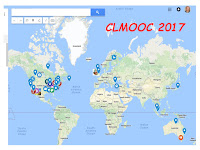
As language arts teachers,
I continue to be honored to participate in these annotations. I'm not a class room teacher. I've spend over 30 years leading non-school, volunteer-based tutor/mentor programs, which bring extra adults into the lives of kids living in high poverty areas.
Through the stories you share I see some great examples of what teaching should be. However, I also sense that most of you are islands within your own school, and that too few others share the same ideas and practices.
As long as it still takes 12 years to go from first to 12th grade, and another 2 to 8 years to move through additional years of formal learning and into jobs and careers (and people will still need support after that), kids will need a full school of great teachers, and a community of support in the non-school hours.
Such systems are needed in thousands of schools across the country.
In this blog article I use this graphic to visualize the goal of spreading ideas like yours to the larger world. 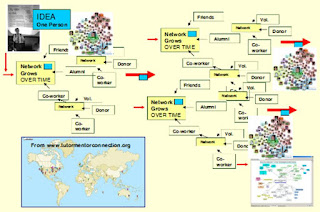
I hope to connect with others who are visualizing ideas of how systems change might be achieved over the coming decades.
homes being disrupted—by divorce, evictions, mental illness, alcohol, or drug addiction.
I read a New York Times story today titled "The Adopted Black Baby, and the White One Who Replaced Her" It shows that all kids grow up with their own sets of disruptions and influences and that just making it to the adult years does not guarantee life will be smooth sailing after that. https://www.nytimes.com/2017/12/07/us/the-adopted-black-baby-and-the-white-one-who-replaced-her.html
The take away for me is that students need to learn how to build networks of support, in the school, the community, work and in life.
We could predict that something interesting and worth doing might arise, but not what would arise.
When you join together to walk into the darkness of an empty space, you can only predict that something interesting and worth doing might arise.
That's a strong reason to take the journey.
Thanks for sharing
we encourage the lean community to join
I'll share this with Jason so that he and his fellow organizers can add their own thoughts, and so they can see how an annotation tool like Hypothes.is might be used to engage members of the community in collective learning.
form a network of practitioners

I use concept maps to visualize "who needs to be involved" and write about using network analysis and GIS maps to show who's involved and understand who still needs to be involved. This is an on-going process that needs to be supported on an on-going basis.
Stanford Social Innovation Review has been writing about Collective Impact for several years, and emphasizes the role of a "backbone organization" and the need for consistent funding. The information collection and analysis that I describe is work that a backbone organizations should be doing. see article
Building appropriate systems
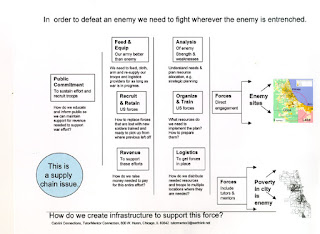
In this article, and many others, I focus on the planning needed to make needed support systems available to k-12 youth and their families in all of the high poverty areas within the Chicago region, or any other defined geographic area.
consider whether we have developed systems in which they can thrive
By coincidence I found two resources in the past week that relate to this:
In a book titled "Diagnosis:Poverty" Marcella Wilson writes about "treating the condition of poverty with a client centered community based continuum of care"
This is a video of a lecture at Harvard by Jeffrey Duncan Andrade, where he talks about educators addressing the conditions of poverty, using social determinants of health similar to what Dr. Wilson was describing.
In both cases they emphasized the importance of HOPE as a force in helping youth and adults overcome the challenges of poverty.
many complex problems
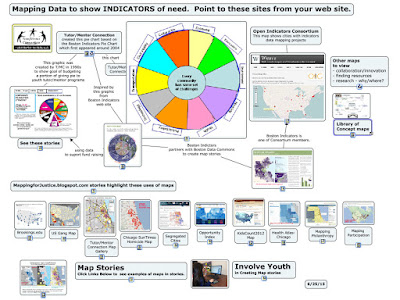
This concept map points to data platforms with information people can use to create maps and visualizations that focus attention on all poverty areas within a geographic area. Included in this article.
problem-solving capabilities are required in every role
While I did print newsletters from 1994 through 2002, and email newsletters from 1998 to the present, I started writing a blog in 2005. Here's from December 2005 where I describe the idea of a learning organization.
unique barriers to overcome

This image shows the many different challenges that face all kids and emphasizes that kids in poverty have fewer resources to help them overcome those challenges.
Expanding the network of resources needs to be the work of every youth serving organization and k-12 school, supported by the business, faith and higher education communities.
engaging the entire community in addressing the root causes of problems
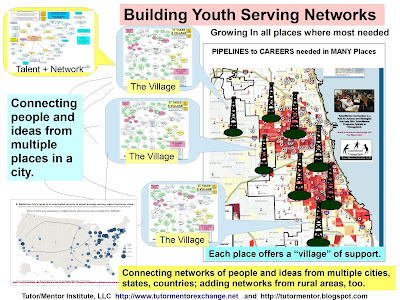
I use this image in this article, showing the need for groups of people to support individual tutor/mentor programs in all parts of the city, while other groups support all similar programs in different neighborhoods, and others focus on the entire city.
When people understand that they can learn and grow, they are able to move forward towards self-sufficiency.
I've led a volunteer-based tutor/mentor program from 1975-2011 and continue to lead an effort intended to help similar programs grow in every high poverty neighborhood. This idea of "helping people understand that they can learn and grow" is fundamental to this work.
Jason Schulist
I was introduced to Jason by Gene Bellinger, a Systems Thinking guru who encourages people to use tools like Kumu.io and Insightmaker. In preparation for a Skype call with Jason held 11/22/2017 I found this article. As I read it I saw parts that I wanted to highlight. So I posted it to Hypothes.is.
You

One person stepping into the void can be the advance scout for an army of concerned people who create a better future for all.
concert
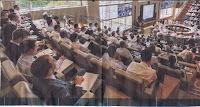
are we all witnesses to the operating room of life?
When do we come to the floor and add our own expertise?
cultivating collaborative relationships
I've been building a web library for past 20 years with links to research and organizations related to helping kids in poverty move through school and into adult lives.
Today Kevin Hodgson shared a link to an Open Education Citation network map
Either of these could be models for aggregating links and building a broader network of ideas and stakeholders.
OpenStax
I wonder what is taking place to encourage more community colleges and 4-year universities to use these text books in their courses, so more kids would benefit. Anyone with information about this?
building the capacity of parents and mentors alongside that of children
This would be good, especially if it's a long-term strategy. Kids who start to use technology as they go through school can become parents more able to model its uses as adults.
The challenge, in the initial stages, would be to develop and sustain programs that attract parents and mentors to be learners and role models.
affluent students often have tech-savvy parents and the latest technology at home,
There is a multiplier affect here. Peers of students in affluent communities may have parents with differing levels of tech interests and experiences. As a group, they tend to reinforce and support each other.
The opposite can exist in poor communities. Even if one student has parents who support tech learning, peers many not have this, and may provide negative reinforcement.
fully anticipate the needs and costs for repair.
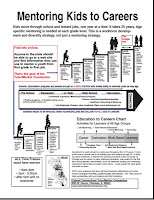 Planning a tech learning strategy needs to reflect the 12 years of continuous learning support needed by each youth. The life cycles on hardware and software meant the entire system might need to renew two or three (or more) times every 12 years. The costs for this need to be taken into account.
Planning a tech learning strategy needs to reflect the 12 years of continuous learning support needed by each youth. The life cycles on hardware and software meant the entire system might need to renew two or three (or more) times every 12 years. The costs for this need to be taken into account.
One reason I've advocated for non-school tutor/mentor programs at business and community sites is that in many cases kids and volunteers can be using technology that the volunteers are updating regularly. I'm not sure how many are taking this into consideration.
developers and reformers
This conversation has to expand to include resource providers, from the private sector, as well as government.
and community
 I've used this graphic since 1990s to show support kids in high poverty areas need, which are naturally occurring to kids in more affluent areas. Such support can be provided by volunteers from different business and work backgrounds, if there is a safe place that encourages sustained involvement over a period of time. Such support can also be made available in non-school hours, at community locations, and even at business locations.
I've used this graphic since 1990s to show support kids in high poverty areas need, which are naturally occurring to kids in more affluent areas. Such support can be provided by volunteers from different business and work backgrounds, if there is a safe place that encourages sustained involvement over a period of time. Such support can also be made available in non-school hours, at community locations, and even at business locations.
While many non-school tutor and mentor organizations do exist in cities like Chicago, I don't see a concerted effort from the schools and city leaders to make them available in every neighborhood, or to help each include a digital learning and mentoring component.
challenges and solutions
Here's a video titled, "Without A Net: The Digital Divide In America" that shows tech inequality in schools. https://www.youtube.com/watch?v=lBAkCgDD-BE&feature=youtu.be
YPAR offers a pathway forwar
 Is anyone doing research, on a school-by-school level, to learn and show where YPAR programs, or something like it, is available? Such research should show levels of engagement, from a few students out of the student population, to different percentages of involvement.
Is anyone doing research, on a school-by-school level, to learn and show where YPAR programs, or something like it, is available? Such research should show levels of engagement, from a few students out of the student population, to different percentages of involvement.
Such maps, with demographic overlays showing the poverty levels of school neighborhoods, would show if these programs are reaching youth in rich and poor areas, or in all parts of the country.
imagine alternative possibilities
Helping young people learn to visualize and/or articulate their vision for the world, or a local problem being solved, is a way to create a passion, and purpose, that can drive student engagement.
YPAR
Here's one YPAR web site.
connected learning
I use hashtags to support connected learning. In this map I aggregate links to a variety of on-line conversations that I've participated in. I can use this to go back to the groups from time to time to see new messages posted, which often contain links to new information that related to the topic.
in online spaces
Lack of internet access still represents a barrier for many youth living in high poverty areas.
we argue fails to take into account the systemic inequalities faced by young citizens of color
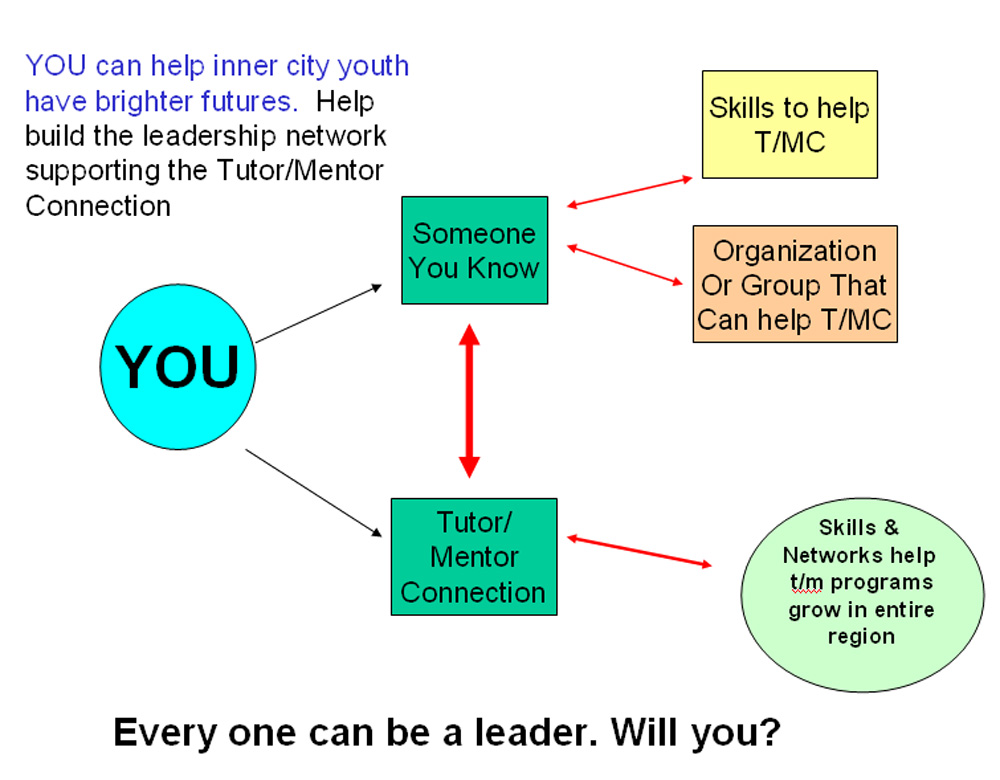 Keep making the case and teach youth to do the same. Creating world we want.
Keep making the case and teach youth to do the same. Creating world we want.
those from high-income families consistently received more civic learning opportunities than students who did not attend well-resourced schools or experience the benefits of family wealth
 I created this map to show that kids in rich and poor neighborhoods face some of the same challenges, but that kids in more affluent areas have more resources to help them overcome those challenges. Included in this article.
I created this map to show that kids in rich and poor neighborhoods face some of the same challenges, but that kids in more affluent areas have more resources to help them overcome those challenges. Included in this article.
story line of inequality
Our Kids: the American Dream in Crisis, by Robert D. Putnam, focuses on this. 
I've written a series of blog articles based on his book.
the role that media outlets play in portraying people of color in stereo-typical and victim-blaming fashion
Maybe this is an invitation to frame a different message. What if after a police encounter, or shooting, friends and family posted positive images of the young people involved? If enough of this happened, on a consistent basis, would it help change the image?
fundamental belief in the virtue of this
One of the wonders of this country is how people who have been abused and disenfranchised have continued to give their time, talent and lives to maker America a better place than the reality they themselves have lived.
Looking forward to reading this after watching the livestream of the Obama Summit on Oct. 31 and Nov. 1. The presentations from that event can be found at Description
we can learn much
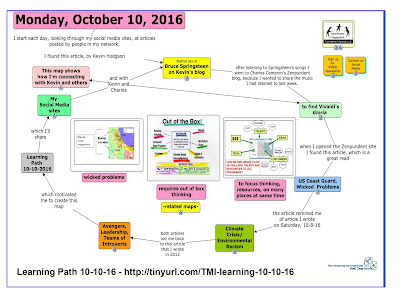 I used this graphic in an Oct. 2016 article where I pointed to articles I had read the previous few days, and tried to make sense of them.
I used this graphic in an Oct. 2016 article where I pointed to articles I had read the previous few days, and tried to make sense of them.
We need to teach youth habits of reading and thinking about what they read, and connecting with others, like we're doing in this annotation, so that more of them bring this habit with them into adult years.
22-year-old describes herself as “an American through and through”
It is already worth my time of coming to this article just to find and watch this video.
we humans ignore what we don’t understand
I've never been a classroom teacher so much of this conversation is something "i don't understand". However, because of my relationship with Terry, Simon and others, I make the effort to read, not just ignore.
digital education
To me educators are people who spend time guiding learners through a huge library of ideas and information. That can be the Common Core learning standards, or the curriculum to get a Phd from Stanford, Duke or Harvard. Learners don't learn everything in a day. The take 12 years just to get a HS certificate and 2 to 10 more to get post HS certificates. They benefit when they are supported by other learners and mentors.
I used ThingLink, which I learned from #clmooc folks, to map a learning path map that I created to guild people through the information and ideas I've been sharing since 1993.
That's a long intro. My point is, in this Manifesto I don't see any mention of the body of information and ideas that educators want learners to read, discuss, share, etc.
The Internet makes the world's knowledge available to anyone with www access. Formal and informal educators are just using digital as well as F2F opportunities to draw learners to this knowledge and help them draw from it on an on-going basis.
Am I missing something?
purpose of supporting online annotation
Has anyone read the which was first circulated in the late 1990s?
Would like to see that annotated with a goal of comparing it's ideas to this Manifesto for Teaching Online.
making better worlds for everyone
A noble goal. Thank you Terry Elliott of the #clmooc group for bringing this to my attention. I'll add it to my library with hopes people in the non-school space will also read it.
One implication that I hope this book has is this: if you want to design a learning environment, don’t start with content, start with the following sorts of questions: “What experiences do I want the learners to have? What simulations do I want them to able to build in their heads? What do I want them to be able to do? What information, tools, and technologies do they need?” Another way to put these questions is: “What games do I want these learners to be able to play?” The first decision, then, ought to be about what are good and useful and powerful experiences for people to have, and what are good and useful and powerful games for them to be able to play
While it might be ideal for teachers in every classroom to be trying to implement these ideas, that seems very redundant. How can colleges who prepare teachers and update their skills regularly form affinity spaces to encourage development of these skills? I suspect the lead will come from education technology companies who take a lead in developing learning games that are as challenging and fun for learners (of all ages) to play as are the games described in this book.
schools
Maybe we need an affinity space to discuss ways to make this form of learning available in schools and in out of school time locations, especially in high poverty areas where it might be most difficult to get such ideas into schools. 
According to neoliberal philosophy, everything should be on a (free) market and people ought to get what (and only what) they can pay for (Hayek 1996; Sowell 1996; von Mises 1997). If, for humane reasons, there has to be, within a given area, something “off market” (i.e. free or subsidized
Countering this will be one of the great challenges of the 21st century.
young people today are often exposed outside of school to processes of learning that are deeper and richer than the forms of learning to which they are exposed in schools.
I propose that volunteer tutors and mentors who meet with youth in organized site based tutor/mentor programs, or via on-line mentoring programs, can help young people from high poverty areas learn to navigate and thrive in this on-line space. While we had computers at the tutor/mentor program I led in Chicago, and volunteers often took this role, there is no data that I know of actually shows how much this is happening or where.
. However, they must also stand ready and able to rearrange these skills, experiences, and achievements creatively (that is, to shape-shift into different identities)
While this document seems focused at k-12 educators and it seems most comments come from that field, these skills need to be taught to adults who are experiencing a rapidly changing work environment and don't have the habits to "learn and rearrange" their skills or build and market themselves in expansive networks.
But for the Millennials segregation is defined more by income than race
Important. While 24% of African Americans and 21% of Hispanics live in poverty in US., for each category this is fewer than the number of White people living in poverty. White 22.3 million; African American 10.3 million; Hispanic 12.1 million. Thus the issue of race is a high priority for minorities because of the large percent, but the issue of class is even greater importance because so many White people are also living in poverty. Data from US Census and Kaiser Family Foundation.
Networks
In this article I include a concept map with links to many social capital articles that relate to this idea. 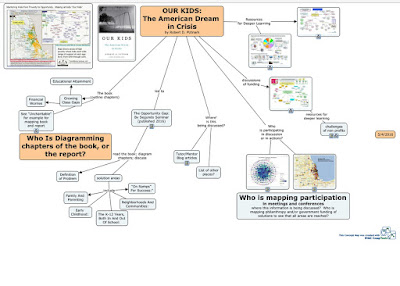
People are brought together through a shared affinity for a common goal, endeavor
We named our new web site tutormentorexchange.net in 1998 with this idea of an affinity space in mind. Never was able to attract sufficient and on-going capital and talent to develop its potential. Still trying.
In turn, people who are adept at taking on new identities, adept at using and interacting within affinity spaces, and are well connected in networks will flourish.
Skills and habits that need to be learned over a period of years.
By one’s portfolio I mean the skills, achievements, and previous experiences that a person owns and that he or she can arrange and rearrange to sell him or herself for new opportunities in changed times.
Very difficult for people who grew up within one company to market their skills this way.
facilitated at home by families with a good deal of mainstream educational and cultural capita
This where the gaps between rich and poor families and communities is of concern.
often organize themselves and others in terms of affinity spaces
In my own experiences I've seen a growing universe of affinity spaces that each seeks to be the center of it's on solar system. Few link to each other the way the RTS space seem to do.
Furthermore, few have a single focus of "the game" which has it's own team of developers and markers working constantly to draw users to the game and to the various affinity spaces.
Newbies and masters and everyone
In reading this complete list an over arching theme is the motivation that drives people to participate in this space.
When a space utilizes dispersed knowledge it means that its distributed knowledge exists in a quite wide and extensive network.
This describes what I've been building for almost 20 years. This article points to the many different sections of the Tutor/Mentor web library. Many of these sections include links to dozens of additional web sites, who each have links to even more web sites.
the endeavor or interest around
People have asked "who is the customer" for the www.tutormentorexchange.net and www.tutormentorconnection.org web site? I respond, "anyone who wants to help inner city kids move safely and successfully through school and into adult lives, jobs and careers."
games change in response to player reactions, but also in the present
The game is rapidly responding to millions of players located around the country. Compare this to how well, if at all, the education establishment is responding to millions of learners in classrooms throughout the US, or the world.
A portal is anything that gives access to the content and to ways of interacting with that content, by oneself or with other people.
multiple modes of interaction
a space in which people interact
From reading the previous sections I can see how the gamers world creates multiple spaces for interaction, as well as motivation to engage on those spaces.
orizontal” learning experience
Some learners need more time at different stages to figure things out, before they go to the next stage. The amount of time on a horizontal stage would differ for each learner and the environment, or support system, would influence that.
importance of supplying all children in schools with the range of necessary experiences
Understanding this and building the public will to make it a reality are vastly different challenges.
pervasive culture of inequality that deskills poor and minority children
I created this concept map to show the challenges facing all children, and additional challenges facing kids in poverty. I emphasize that kids in more affluent areas have more resources to help them overcome their challenges than do kids in poor areas. See article. 
process
As we think of culture and process consider how families and communities stay connected to youth from the time they are born till they are adults, in jobs, and living on their own (even then they stay connected). The public school system passes kids from teacher to teacher on an annual basis, and even from school to school as they move from elementary to middle then high school. What sort of relationship continuity and influence does this offer? 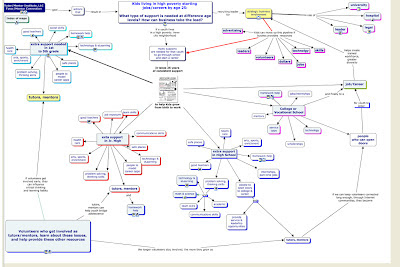
deep learning works better as a cultural process
As we relate this back to discussions of the experience and opportunity gap between rich and poor students I encourage reflection on the role of adult mentors in organized non-school youth organizations. Such programs can expand the range of experiences youth have, through the volunteers and their own backgrounds. 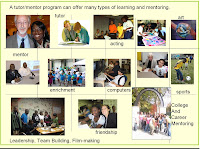
School can’t compete
I heard the CEO of Motorola speak to a group of educators in the late 1990s. He said "you'd do better if you'd treat kids and parents as customers". One person stood up and said "but they don't teach us that in education schools".
I've heard some belittle this comparison of students to customers, but the core comparison is that if youth are not interested and motivated they won't learn very well.
Educators need to figure this out.
Who, then, are the children who do not fare well in early reading?
 In this article I point to a concept map with many different data maps. We need a similar collection of maps that show education performance indicators, at the zip code level, and by age group, race, etc. Only then can we really understand "who" is not faring well and focus on different solutions for different problems.
In this article I point to a concept map with many different data maps. We need a similar collection of maps that show education performance indicators, at the zip code level, and by age group, race, etc. Only then can we really understand "who" is not faring well and focus on different solutions for different problems.
Can anyone point to some platforms that visualize this data effectively?
Privileged children (children from well-off, educated homes) often get an important head start
The "Our Kids: American Dream in Crisis" book by Dr. Robert D. Putnam, emphasizes this gap, which widens as kids grow older. I wrote about the book here.
how to get all children—rich and poor—to be successful in schoo
 As I read through this paper I hope to find uses of maps to focus conversation on strategies that actually reach youth in all poverty areas of the US and the world.
As I read through this paper I hope to find uses of maps to focus conversation on strategies that actually reach youth in all poverty areas of the US and the world.
If you didn’t like school,
I'm not an educator, but have led volunteer-based tutor/mentor programs connecting inner city Chicago youth with adult volunteers for over 30 years. Finding ways to bring non-educators to articles like this is one of the challenges I focus on.
I've already learned something new, re: headless relatives and naked infinitives.
Alex Smith devotes an entire page
What's the link to this page and the podcast?
Recommendations
Thank you again for sharing this on Hypothesis. I read it as I would have read a printed report, and highlighted passages that resonated with me.
Here's a page on my web site where I show my own interest in social network analysis and share some articles and links to work I've had done by myself and interns.
CLMOOC has changed since 2013, both from an evolution and maturity perspective, and due to change in available resources to support the planning and communications of activities.
It would be great to find a university that is teaching network analysis who would take a long-term look at CLMOOC and on-line communities, showing growth and change over a period of years.
I also think more needs to be done to understand the value of "likes and retweets" and how they help build visibility and reputation and can help the group grow.
In addition, an analysis of how blogs are being used by members to share what is happening, what is learning, and to reach others who may not be active or LPP members, or who may not be using the platform that you're using to measure participation.
Lots to do. A benefactor is needed.
Perhaps instead of ‘pathologizing’ peripheral learning, we should instead view peripheral learning as a form of honoring voices from afar, and accepting that as a means of learning.
I hope this becomes the norm.
Facebook, Google+, Twitter
An analysis would need to compare groups on the three platforms to determine how many use all three, or two, or only one.
it is, and it works for them
“If I had more time and was not involved so much in work commitments after hours then I would participate more. I’m not sure what would motivate me to do the suggested makes. Maybe I’m just uninspired at the moment. It happens.” [Participant 2]
It would be interesting to expand this analysis to look at the member map for 2016 and 2015. I think there were more on the 2015 map. However, what I noticed that there was small participation from bigger cities like Chicago. I would expect with a larger number of students and educators, the cities would have greater participation.
Does time available to participate differ in cities? Or, to more opportunities to connect f-2-f reduce motivation to connect on-line?
time is a major reason why participants do not actively engage
From 2007 when I started following some of the cMOOC originators the ideas of "you can't do it all, so do what you can" was a common mantra. Not feeling a failure for lack of time or not "doing everything" gave freedom to participate when and how often anyone wanted to.
Twitter gathers more posts more quickly and I like that, plus the hashtag search is effective. FB is something I already use regularly, so it doesn’t take additional time/effort. G+ is hard to follow and awkwardly organized.”
I hope this research becomes longitudinal, looking back to 2010 and 2011 and forward into an unknown future. The dramatic changes in platforms, and how well they support user interactions, would probably influence community participation. Unless on-going mapping of participation is done, this type of analysis is not possible.
In a graded classroom context this might make sense given that the learners are evaluated for credit, however in an open community do these same metrics make sense?
Most of the CLMOOC participants were educators and much of what was discussed related to their work with student learners at the k12 or college level.
I try to focus this process to engaging adults in learning about local and global issues which affect their lives, and which require their understanding and involvement, if the problems are to be resolved. This also might apply to a business or social enterprise where a group is learning in order to capitalize on an opportunity.
LPPs had more transparent or invisible connections,
Using SNA tools like Mention Map researchers could look at the Twitter network for each LPP to get an idea of how large their network is and of who they connect with. Such analysis would likely show how the information being shared in the group is potentially being passed on to a much wider network of people.
Rather, peripheral learning is about engaging silently with invisible social ties and ongoing conversations that are happening in the network.
a positive perspective
legitimate peripheral participants (LPPs)
How about EARS (Engaged, although rather silent)?
different perspectives on how participation in online communities can be conceptualized,
Sarah, did your group look at the evolution of on-line communities from list serves in the late 1990s to the cMOOCs of today? On list serves there were far more people following, and hopefully reading, than there were who were actively posting and engaging.
However, in an online environment, someone who isn’t speaking up (providing verbal postings) isn’t necessarily someone who isn’t paying attention, and it is not necessarily appropriate to quiz them.
Does learning only happen if it can be tested and measured? Question appies for on line and off line.
They write that “online groups can gather to complete organisational work tasks or short-term projects, virtual communities are longer-term, emergent, and based on personal relationships”
The middle ground between these two definitions, might be groups formed with the goal of bringing people together in actions that lead to more formal actions to solve community problems.
This is an interesting point of view because it puts lurkers in a position to be “managed” in communities where they, by and large, volunteer their time and content.
Even if they are not active they are validating the work of the group by how they spend their time looking at content and posts shared by others.
Media platforms tend to see non-participation, or little participation, as potential lost revenue. However, in educational contexts it is important to question this unquestioned assumption of non-participation.
While I track visitors to my web sites and blogs, I really don't know someone has visited the site and used the information unless they tell me. I had one person say to me many years ago "we built our entire organization based on information from your web site". I only learned this via a chance encounter.
From a financing and fund raising perspective, this has always been frustrating.
By commenting and forwarding one’s own reviews or other authors’ reviews, the members of the class multiply and therefore amplify the scope of these reviews
 I take this role as part of an ongoing effort to draw more attention and resources to all of the non-school tutor/mentor programs operating in Chicago. I try to model a set of behaviors that others will duplicate, for the same purposes, since my actions alone are too small to dramatically influence the actions of volunteers, donors and others in a huge city like Chicago.
I take this role as part of an ongoing effort to draw more attention and resources to all of the non-school tutor/mentor programs operating in Chicago. I try to model a set of behaviors that others will duplicate, for the same purposes, since my actions alone are too small to dramatically influence the actions of volunteers, donors and others in a huge city like Chicago.
community member that is identified as a lurker can be an active participant in another community,
I am more active in some communities than in others.
have negative connotations
I guess this partially answers the question I posted above.
research questions
I'd ask one more set of questions, such as "is lurking" a negative term? Is there a label being applied that might discourage some from even taking a first step into the on-line community?
lurking learners can move inwards through the layers
As I read further I hope to see graphics that illustrate change over time. When I joined CLMOOC in 2013 I was an outsider, and mostly a lurker, learning from what others were sharing. I still am in that role most of the time, but over four years I've developed some strong relationships and participate in many ways, such as reading this paper and commenting in the margins.
Abstract in Turkish
The abstract is translated into five languages! Wonder how many other published papers do this.
social network analysis,
This is something I've been interested in for many years. Look forward to seeing how it's used in this paper.
CLMOOC.
Here's the CLMOOC homepage.
This is the CLMOOC G+ page.
I saw this article posted on Facebook by Sarah Honeychurch and started to read it. I did not get very far before I was thinking of taking out my yellow marker to highlight sections important to me. That prompted me to ask Sarah if she'd be willing to open this for annotation, using Hypothes.is. She did, and that's what made it possible for myself and others to read, reflect and comment in the margins. Thanks Sarah and her co-authors.
Add some more
 If you browse articles tagged "influence" on my blog you'll find this graphic in the first one, under a headline of "So you're trying to duplicate what kids have in affluent areas?"
If you browse articles tagged "influence" on my blog you'll find this graphic in the first one, under a headline of "So you're trying to duplicate what kids have in affluent areas?"
I missed this article when you first posted it in May, but today as I used inoreader to see the latest articles you, Kevin and others have posted, I saw your reference to this, and thus took a look.
One of the challenges I feel blogs present is that articles written a few weeks ago, or a few years ago, may be as valuable as ones written today. Finding ways to encourage others to look back into the archives is something I look for daily.
Perhaps I could use it for:
This list is how hope my library is used not just by students, but by civic groups, business, faith groups, etc. or anyone concerned with poverty, young people and similar issues that I focus on.
I stripped out the relevant links using LinkGrabber and put them into Dropbox’s Papers.
This process is similar to what I've done since 1998 as I've built the web library that I point to at http://tutormentor.blogspot.com/2017/05/list-of-articles-that-i-point-to.html
honoring those who invited me and those who are sharing.
In that spirit I thank you Terry for for reaching out in 2014 to interview me and welcome me into the #clmooc. http://tutormentor.blogspot.com/2014/06/connecting-network-building.html Since then I've come to know and admire work that you, Kevin and others are sharing and I've a growing list of "tools" that I use daily, including this annotation, that I would know know about otherwise.
I think I honor this the most by how often I try to connect others to this network so they can start the same journey for themselves.
I misunderstood what #DigCiz was mostly about.
 We each enter a conversation space with different expectations, based on our own goals and experiences. With such a broad term as 'digital citizenship' it's not surprising that many visitors may have different expectations that those of others, or the organizers.
We each enter a conversation space with different expectations, based on our own goals and experiences. With such a broad term as 'digital citizenship' it's not surprising that many visitors may have different expectations that those of others, or the organizers.
not seeing much on how to practice digital hospitality
I tend to disagree. I've followed the articles Terry, Kevin, Sheri and Sarah have been writing, and that led to the Digg platform and this annotated blog and more places than I've found time to visit, or yet even know about. Accumulated hospitality, and trust, motivate me to take steps on this journey. Without someone first setting up the #digdiz domino affect, much of what I've seen in the past few weeks would not have happened.
I wanted something very different
 I posted this graphic in article at https://tutormentorexchange.wordpress.com/2017/06/17/joining-in-on-digciz-discussion/ to show a different goal of #digciz
I posted this graphic in article at https://tutormentorexchange.wordpress.com/2017/06/17/joining-in-on-digciz-discussion/ to show a different goal of #digciz
will carry on for awhile
I have continued to venture into these spaces because the newspapers keep reminding me of a problem that has never been solved.
engagement is risky
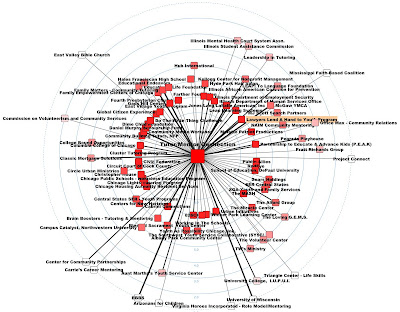 This map shows participation in May and November 09 Tutor/Mentor Conference held in Chicago. It's part of article at http://kalyanimisra.blogspot.com/2010/10/social-network-analysis-of-may-09.html
This map shows participation in May and November 09 Tutor/Mentor Conference held in Chicago. It's part of article at http://kalyanimisra.blogspot.com/2010/10/social-network-analysis-of-may-09.html
The volunteer who did this work was only with me for a short time. I have never been able to get anyone continuously involved in doing this work. Thus, I've also never been able to do more to help those attending the conference connect with each other off line, or on-line, or to collect information that could demonstrate if it is, or is not, happening.
only a “few but fine” who want to play crack the whip with me on the other end
I wrote an article this morning, before reading your article, that shows my goal of bringing Chicago tutor/mentor programs together on Twitter. It's not happening that I can see. http://tutormentor.blogspot.com/2017/06/engaging-chicago-tutormentor-orgs-on.html
Martin Hawksey’s event hashtag visualization :
I've been interested in mapping participation in events for almost 10 years. Here's a set of articles from my blog that show this. http://tutormentor.blogspot.com/search/label/network%20analysis
"infrastructure fluency
I draw ideas and relationships from a wide range of resources (horizontal network) which I apply in a focused effort (vertical) aimed at changing futures for youth born or living in high poverty areas. Would love to see articles like this focused on specific issues, like climate crisis, poverty, public health, etc.
complex information stocks and flows
 I created this cMap to show entry points into information related to poverty, inequality, etc. See at http://tutormentor.blogspot.com/2017/01/drill-down-into-maps.html
I created this cMap to show entry points into information related to poverty, inequality, etc. See at http://tutormentor.blogspot.com/2017/01/drill-down-into-maps.html
Hierarchies and networks
I started thinking of "vertical" and "horizontal" networks in the late 2000s. This article focuses on that. http://tutormentor.blogspot.com/2014/09/knowledge-based-problem-solving-what-is.html
analysis paralysis
In past few years I've become paralyzed in a way because I understand that the massive amount of information I've aggregated in my web library and blogs is just too much for most people to comprehend in just a few sound bytes or elevator conversations. People's eyes glaze over when I'm introducing myself to them. That tends to make me fearful of making such introductions.
Unlike pure-paradigm architectures, rhizomes mix and match multiple architectural paradigms along with emergent structures to create high-dissonance information environments.
As I read this I think of this tag cloud that show categories of ideas on my http://tutormentor.blogspot.com blog 
the sheer complexity of the IT stack
 I see this as a two sided problem. On one side is the complexity that lessens most people's access and on the other side is the increasing costs of access (hardware, software, fees, etc.),
I see this as a two sided problem. On one side is the complexity that lessens most people's access and on the other side is the increasing costs of access (hardware, software, fees, etc.),
do they engage and form connections with the larger, outside world
I came to this article by reading a post by Simon Ensor, who I met as a result of joining the #clmooc in 2013 and staying engaged since then. I'm not a traditional educator. I've led non-school, volunteer-based tutor/mentor programs in Chicago since 1975. Part of that time I was a volunteer myself holding full time retail advertising jobs with a large retail corporation. Thus, I'm part of the "outside world" I think you're referring to. I enjoy the freedom of being able to learn from this and other articles, on my own time, and for my own purposes. I hope that others who are not traditional educators will learn to do the same.
What do you think?
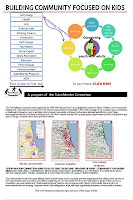 I've 10 years of articles at http://tutormentor.blogspot.com that I'd love to have people post to Hypothesis and start discussing.
I've 10 years of articles at http://tutormentor.blogspot.com that I'd love to have people post to Hypothesis and start discussing.
I believe tools like Hypothesis give space for collaborative discussions, allowing the margins of the text to come alive with conversation and questions and associative linking that extends the thinking of the original writer
I see this potential and am disappointed that I don't find more people in the non-school ecosystem using Hypothes.is to engage with each other, and with donors and other supporters.
allow you to annotate most websites and blogs
I was introduced to Hypothesis and annotation by Kevin and Terry Elliott in January 2016 and I've joined in the margins on several conversations, such as this. However, I've been cautious about launching an annotation of someone else's blog, not knowing the etiquette. Just a week or so ago I saw an article posted in the #ds106 site and as I read it, had the urge to want to comment on ideas I was reading. I tweeted to the author and encouraged the article to be set up on Hypothesis, but have not seen that happen. To me, that's a loss, because I felt the ideas in the article deserved to be viewed by more people. I did not feel comfortable with posting it on Hypothes.is myself.
Why else post your writing if not to engage a reader?
This is why I post, and what causes me to assume that others post for the same reason. I've found that this is not the case for many.
As being a Muslim was perceived as a threat
With so much negative pressure, it's a wonder that more youth are not being radicalized than there are (or that we're aware of). In the video about the Black experience in America, that I posted above, there are several hundred years of oppression that could have radicalized African Americans. Yet, that does not seem to have happened...yet.
The power of the American experience, as opposed to the experience of Muslims in Europe, seems to provide a sense of hope and optimism, that keeps people working to be accepted and thrive in this society. Let's hope that remains true.
because of 9/11
I wonder if the rise of ISIS since the late 2000s is an even larger contributing factor than 9/11.
You cannot be a good American and a good Muslim” narrative
Unfortunately, as I'm reading this article, I feel I'm only at the beginning of a story that has many unwritten chapters that will play out over the next few years and decades.
Activists, like prophets, politicians, and advertising executives, have long recognized the power of a good story to move people to action”
This is a role that needs to be learned, and can be taken by many who fall in the range between "activists" and "not involved". Anyone who shares a link to this story on social media, a blog, or a conversation is taking this role.
online expression may attract unwelcome scrutiny
I can't imagine the level of paranoia and fear these youth face on a daily basis, which is only heightened by what's happening on the world stage, and by the leadership we now have in DC.
a precarious public
"one where there is a considerable gap between voice and influence.”
civically engaged American Muslim youth
This map shows distribution of Islamic population in the US. From http://www.dailymail.co.uk/news/article-2138365/The-changing-face-religious-America-Number-Muslims-U-S-doubles-9-11-Mormonism-spreads-East-Coast.html 
a climate increasingly defined by privacy and surveillance concerns
I just listened to the webinar and heard Sangita Shresthova talking about this, and how the concern extends to Hispanic heritage youth as well. I expect to be challenged by what I read in this chapter and in the margins.
My work has focused mostly on African American youth, who face many struggles, and mistrust by others, but I don't think they face the same type of potential surveillance in online space as do these youth.
Maybe there is some common ground in this.
While you are annotating, you can also keep a lookout for others who will be annotating with Hypothesis, and engage with them throughout the week.
After participating in a group annotation last November I created a story map to show who I was connecting with. Do you have any plans to map participation in this week's efforts? http://tutormentor.blogspot.com/2016/12/mapping-week-of-learning.html
advance educator professional development about education in/equity through the use of participatory learning technologies
It's great to see how you are using Twitter, webinars, annotation to engage stakeholders in this discussion of education inequity. I'm listening to the webinar now.
In July 2011 the Tutor/Mentor Institute, LLC
In 2011 the Board of Directors at the organization I founded in 1992 and led 19 years decided to discontinue support for the Tutor/Mentor Connection, due to huge financial challenges and their own limited understanding of how the T/MC had contributed to the growth of the site based tutor/mentor program we had also created in 1992. I was invited to 'retire' so a younger person could take the lead, but was given ownership of all T/MC assets.
I did not have a team of volunteers and leaders to create a new non profit structure, so created the Tutor/Mentor Institute, LLC, using the site at http://www.tutormentorexchange.net as its home page.
That site had been created in 1998 in an emergency when the T/MC site crashed just prior to a volunteer recruitment campaign launching. We used it to share our list of Chicago tutor/mentor programs. In the years since, I used it to share illustrated PDF essays that showed the ideas and strategies of the T/MC.
Those PDFs are aggregated at http://www.tutormentorexchange.net/library but they are embedded in articles in every section of the web site, in my blogs, and in my Tweets and Facebook posts.
This is accomplished through a four part strategy
This strategy was developed in 1993 with help from a Chicago public relations firm and has been followed for over 24 years. It's still relevant. Needs many more leaders and supporters.
mission of the Tutor/Mentor Connection
Scroll down and see a PDF presentation that shows the goal of collecting and sharing information as part of building a network of peers, partners and supporters.
How Was the Tutor/Mentor Connection Created?
This section shows how the Tutor/Mentor Connection started in 1993 as a result of network building and learning from peers that I started in 1975 when I first became the volunteer leader of a tutor/mentor program in Chicago....while holding a full time retail advertising job with the Montgomery Ward corporation.
Will write a follow up post with the other 10 features of affinity spaces and how they apply to VC
Thanks for writing this. Can you include some links to a couple of VC articles that talk more about this? How is Virtually Connecting different than a cMOOC? Do you find any who are using Google maps to show participants in a VC event? Our using social network analysis maps?
In one section of my web library I post links to "education innovations, MOOCs and Learning/Networking sites. I'd like to add a link or two to VC related sites.http://www.tutormentorconnection.org/LinksLearningNetwork/LinksLibrary/tabid/560/agentType/ViewType/PropertyTypeID/7/Default.aspx
backchannel on Slack of “buddies
I wonder how many past public conversations are now being held in Slack. I'm part of a couple. As this grows not sure it's a good thing. Creates new "silos" of "insiders" vs "community". Depends on how easy it is for new people to join.
a lurker or occasional Participant
This is role I've taken in the education MOOC community since 2012. In doing so I've built some strong and growing relationships.
through real-life work
Are teachers incorporating service learning into their efforts?